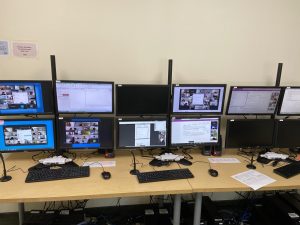
Computer-Based Tests: Raise Your Score
More than ever before, students are faced with paperless tests formats. While it initially may seem like a small change, computer-based tests have their own unique set of obstacles and peculiarities that students must navigate in order to raise their score.
That’s why we’re sharing 3 quick tips for boosting your computer-based testing performance!
Tip #1: Take the Test with Your Hands, Not Your Eyes

Computer-based testing, in many cases, reduces reading speed and information retention. Unlike a paper test, you cannot easily highlight, underline, or make notes next to the information presented.
Therefore, it’s very important for students to summarize key words or information on scrap paper.
The more you try to do everything in your head, the more likely you will re-read a problem several times, miss important information, tire your brain, and make silly mistakes.
You need to use your hands as much as possible. This is especially true for math problems! You must initiate the setup of your problem as quickly as possible after reading the question.
Boost your speed and productivity by jotting down the essentials. Remember, most tests have a time limit, so you don’t have time to write down every word.
If it’s a word problem, it’s important to write down the key details:
- Numbers given
- Units used
- Summarize important info
- Summarize the question
Here’s a quick example of an Algebraic Word Problem:
Scratch Paper Notes, while reading problem:

Because I can’t underline parts of the question like I could on a paper test, as I’m reading the word problem, I’m summarizing the key information in short, mathematical terms. I’ve noted that the units are feet. I’ve shortened top shelf to T, middle shelf to M, and bottom shelf to B, and I’ve summarized the key information into mathematical terms.
Now I won’t have to re-read the problem three or four times, and I’ve already taken a huge step toward solving the problem by setting up my initial linear equations.
For English, you can apply a similar idea.
Here’s an example from an online ISEE Sentence Completion question:
Scratch paper notes, while reading problem:

By jotting down key descriptions and noting the important contrasting word “but,” I know that I’m looking for an answer choice that would be the opposite of normal or sociable.
Rather than spending a lot of time re-reading the sentence and plugging in answer choices, I can now quickly scan the answer choices to find the word that would mean both abnormal and unsociable which is (D)recluse.
For tests that require you to read long passages and then answer questions about it, the inability to annotate your passage – make notes, highlight key sentences, underline main ideas – may be especially frustrating and cause a great deal of extra time and effort.
However, even here you can use scratch paper to cut down on your re-reading.
Here’s an example from an online SSAT reading passage:
Scratch paper notes, while reading passage:

Notice that my notes are short, abbreviated and to the point. It’s not about capturing every detail. Your notes should be a quick reference, so that when you’re answering questions, you know in which paragraph to look for the answer. You can also quickly answer “big picture” questions such as:

A quick glance at my notes, tells me the answer has to be (E) Zeus and His Brothers.
Key Reminder: All of these examples of scratch paper work are examples of notes a student should take while reading the problem, question, or passage – NOT after. Remember, this is a strategy to save time and boost information retention.
Tip #2: Keep your work organized and write necessary intermediate steps
This next tip is specific to math tests. It’s incredibly important that you do not solve problems in your head!
Writing down each step will not only improve accuracy and reduce silly mistakes, but it is a great way to trouble-shoot issues if your attempted problem-solving starts to go in the wrong direction.
For a great and detailed example of the best way to set-up your scratch paper work, check out our other blog 5 Ways to Stop Making Silly Mistakes on Math Tests.
Tip #3: Keep track of the timer always!

This last one may seem obvious, but it’s so important, and something students often struggle with.
Most computer-based tests are timed, and you should always be aware of how much time is left.
One of the keys to good time management on a test is simply being aware of the time. You don’t want to look up at the clock and realize 20 minutes has gone by and you’ve only worked two problems.
Taking consistent practice tests is one of the best ways to become better at time management. Practice checking the time frequently. Train yourself to notice 5-8 minute intervals of time. Through keeping track of the time, especially when you’re taking practice tests, you can start to more accurately judge what your pacing should be for a test. It will also cue you in to when it’s time to move away from a question, so you don’t sink 15 minutes into one problem!
Putting it All Together
The best way to improve on any test – paper or computer-based – is to make changes to your behavior. If you take the test the exact same way, and just “try harder” or “concentrate more,” you won’t see the improvements you want as quickly as you want.
Most students are already trying really hard on a test. What needs to change is how you take the test. Take these 3 tips and start implementing them right away!
For more expert guidance call 855-346-1410 or contact us here.
We can’t wait to hear from you!






